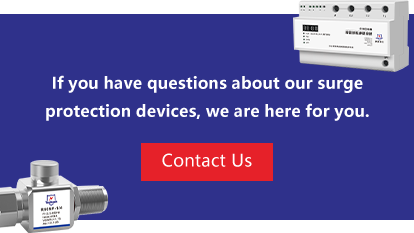A Surge Protective Device (SPD) is a critical component designed to safeguard electrical systems and equipment from voltage surges caused by lightning strikes, power grid fluctuations, or switching transients. SPDs divert excess voltage to the ground, clamping the voltage to a safe level and preventing damage to connected devices.
1. Components:
Metal Oxide Varistors (MOVs): Voltage-dependent resistors that clamp surges.
Gas Discharge Tubes (GDTs): Ionize to create a low-resistance path during surges.
Transient Voltage Suppression (TVS) Diodes: Fast-acting components for sensitive electronics.
Types:
Type 1 (Service Entrance): Installed at the main electrical panel to handle large external surges (e.g., lightning).
Type 2 (Distribution Panels): Used in subpanels to protect against residual surges and switching transients.
Type 3 (Point-of-Use): Installed near sensitive devices (e.g., outlets) for localized protection.
1. Selection:
Choose the SPD type based on location (Type 1 for main panels, Type 2 for subpanels, Type 3 for outlets).
2. Ensure compatibility with system voltage (e.g., 120/240V single-phase, 480V three-phase).
Safety Precautions:
1. Turn off power at the main breaker before installation.
2. Use appropriate personal protective equipment (PPE).
3. Mounting:
Type 1/2: Mount on a DIN rail or enclosure near the electrical panel.
Type 3: Install directly at outlets or within power strips.
4. Wiring:
Single-Phase: Connect line (L) and neutral (N) conductors to the SPD terminals, then ground (PE) to the grounding bus.
Three-Phase: Connect all phases (L1, L2, L3), neutral, and ground.
Use short, straight conductors (≤0.5m) to minimize impedance. Follow manufacturer guidelines for wire sizing (e.g., 10 AWG).
5. Grounding:
Ensure a low-impedance path to the grounding electrode system.
Bond all grounding points to prevent potential differences.
6. Cascaded Protection:
Combine Type 1 (main panel), Type 2 (subpanels), and Type 3 (outlets) for layered defense.
7. Compliance:
Adhere to standards like NEC Article 285 (North America) or IEC 61643 (international).
Indicators: Check LED status lights regularly to confirm functionality.
Replacement: Replace SPDs after major surges or when indicators signal end-of-life.
Inspection: Periodically inspect for physical damage or degradation, even without surges.
Common Mistakes to Avoid:
Using overly long grounding wires.
Mixing SPD types improperly (e.g., installing Type 3 at a main panel).
Ignoring coordination between SPDs in cascaded systems.
By following these guidelines, SPDs effectively mitigate surge risks, ensuring prolonged equipment lifespan and system reliability. Always consult spd manufacturer instructions and local codes for precise installation details.
 The Importance of Power Surge Monitoring Devices: Safeguarding Your ElectronicsSeptember 11, 2023In today's digital age, we rely on electronic devices more than ever before. From smartphones and laptops to refrigerators and home entertainment systems, our lives are intertwined with electronic...view
The Importance of Power Surge Monitoring Devices: Safeguarding Your ElectronicsSeptember 11, 2023In today's digital age, we rely on electronic devices more than ever before. From smartphones and laptops to refrigerators and home entertainment systems, our lives are intertwined with electronic...view How Important is Installing Camera Signal Surge Protectors?March 13, 2023Network camera lightning protector, network camera lightning protection, camera lightning protector, KAIYUAN network camera, surge protector suitable for AC/DC power supply and network interface monit...view
How Important is Installing Camera Signal Surge Protectors?March 13, 2023Network camera lightning protector, network camera lightning protection, camera lightning protector, KAIYUAN network camera, surge protector suitable for AC/DC power supply and network interface monit...view What Are the Experimental Requirements for the Leakage Current of the Surge Protector?August 10, 20221. The value of surge protector discharge current protection equipmentIn addition to the discharge current, the lightning protection capability also depends on the test waveform. The outdoor incoming ...view
What Are the Experimental Requirements for the Leakage Current of the Surge Protector?August 10, 20221. The value of surge protector discharge current protection equipmentIn addition to the discharge current, the lightning protection capability also depends on the test waveform. The outdoor incoming ...view Price and Brand of Lightning ArresterJanuary 10, 2022A surge protector, also called as surge diverter, surge suppressor, or surge protection device (SPD), is an appliance designed to protect electrical devices from induced lightning.1. How about the sur...view
Price and Brand of Lightning ArresterJanuary 10, 2022A surge protector, also called as surge diverter, surge suppressor, or surge protection device (SPD), is an appliance designed to protect electrical devices from induced lightning.1. How about the sur...view Guide to the Function and Selection of Surge Protection Device for LightningMarch 18, 2025As lightning hazards pose increasing threats to buildings and electronic devices, Surge Protection Device for Lightning has become particularly important in modern buildings and power systems. This ar...view
Guide to the Function and Selection of Surge Protection Device for LightningMarch 18, 2025As lightning hazards pose increasing threats to buildings and electronic devices, Surge Protection Device for Lightning has become particularly important in modern buildings and power systems. This ar...view How to Determine the Quality of a Surge Protector against Lightning?September 11, 2023The surge protector is in high demand in the current market and is required in many places. If you want to buy a better quality product, you must learn to judge the quality of the lightning-proof surg...view
How to Determine the Quality of a Surge Protector against Lightning?September 11, 2023The surge protector is in high demand in the current market and is required in many places. If you want to buy a better quality product, you must learn to judge the quality of the lightning-proof surg...view